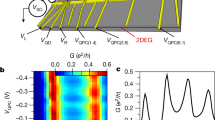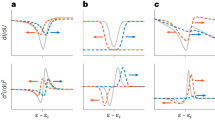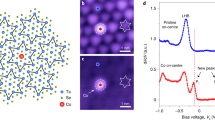Abstract
Two magnetic atoms, one attached to the tip of a scanning tunnelling microscope and one adsorbed on a metal surface, each constituting a Kondo system, have been proposed as one of the simplest conceivable systems potentially exhibiting quantum critical behaviour. We have succeeded in implementing this concept experimentally for cobalt dimers clamped between a scanning tunnelling microscope tip and a gold surface. Control of the tip–sample distance with subpicometre resolution enables us to tune the interaction between the two cobalt atoms with unprecedented precision. Electronic transport measurements on this two-impurity Kondo system reveal a rich physical scenario, which is governed by a crossover from local Kondo screening to non-local singlet formation due to antiferromagnetic coupling as a function of separation of the cobalt atoms.
This is a preview of subscription content, access via your institution
Access options
Subscribe to this journal
Receive 12 print issues and online access
$209.00 per year
only $17.42 per issue
Buy this article
- Purchase on Springer Link
- Instant access to full article PDF
Prices may be subject to local taxes which are calculated during checkout






Similar content being viewed by others
References
Hewson, A. C. The Kondo Problem to Heavy Fermions (Cambridge Univ.Press, 1993).
Löhneysen, v. et al. Non-fermi-liquid behavior in a heavy-fermion alloy at a magnetic instability. Phys. Rev. Lett. 72, 3262–3265 (1994).
Mathur, N. D. et al. Magnetically mediated superconductivity in heavy fermion compounds. Nature 394, 39–43 (1998).
Grigera, S. A. et al. Magnetic field-tuned quantum criticality in the metallic ruthenate Sr3Ru2O7 . Science 294, 329–332 (2001).
Klein, M. et al. Signature of quantum criticality in photoemission spectroscopy. Phys. Rev. Lett. 101, 266404 (2008).
Sachdev, S. Quantum criticality: Competing ground states in low dimensions. Science 288, 475–480 (2000).
Georges, A. & Meir, Y. Electronic correlations in transport through coupled quantum dots. Phys. Rev. Lett. 82, 3508–3511 (1999).
Jayaprakash, C., Krishna-murthy, H. R. & Wilkins, J. W. Two-impurity Kondo problem. Phys. Rev. Lett. 47, 737–740 (1981).
Jones, B. A. & Varma, C. M. Study of two magnetic impurities in a fermi gas. Phys. Rev. Lett. 58, 843–846 (1987).
Jones, B. A., Varma, C. M. & Wilkins, J. W. Low-temperature properties of the two-impurity Kondo hamiltonian. Phys. Rev. Lett. 61, 125–128 (1988).
López, R., Aguado, R. & Platero, G. Nonequilibrium transport through double quantum dots: Kondo effect versus antiferromagnetic coupling. Phys. Rev. Lett. 89, 136802 (2002).
Simon, P., López, R. & Oreg, Y. Ruderman–Kittel–Kasuya–Yosida and magnetic-field interactions in coupled Kondo quantum dots. Phys. Rev. Lett. 94, 086602 (2005).
De Leo, L. & Fabrizio, M. Spectral properties of a two-orbital Anderson impurity model across a non-Fermi-liquid fixed point. Phys. Rev. B 69, 245114 (2004).
Craig, N. J. et al. Tunable nonlocal spin control in a coupled-quantum dot system. Science 304, 565–567 (2004).
Jeong, H., Chang, A. M. & Melloch, M. R. Kondo effect in an artificial quantum dot molecule. Science 293, 2221–2223 (2001).
Chen, W., Jamneala, T., Madhavan, V. & Crommie, M. F. Disappearance of the Kondo resonance for atomically fabricated cobalt dimers. Phys. Rev. B 60, R8529–R8532 (1999).
Wahl, P. et al. Exchange interaction between single magnetic adatoms. Phys. Rev. Lett. 98, 056601 (2007).
Néel, N. et al. Two-site Kondo effect in atomic chains, Preprint at http://arxiv.org/abs/1105.3301.
Sela, E. & Affleck, I. Nonequilibrium transport through double quantum dots: Exact results near a quantum critical point. Phys. Rev. Lett 102, 047201 (2009).
Madhavan, V., Chen, W., Jamneala, T., Crommie, M. F. & Wingreen, N. S. Tunnelling into a single magnetic atom: Spectroscopic evidence of the Kondo resonance. Science 280, 567–569 (1998).
Madhavan, V., Chen, W., Jamneala, T., Crommie, M. F. & Wingreen, N. S. Local spectroscopy of a Kondo impurity: Co on Au(111). Phys. Rev. B 64, 165412 (2001).
Eigler, D. M., Lutz, C. P. & Rudge, W. E. An atomic switch realized with the scanning tunnelling microscope. Nature 352, 600–603 (1991).
Limot, L., Kröger, J., Berndt, R., Garcia-Lekue, A. & Hofer, W. A. Atom transfer and single-adatom contacts. Phys. Rev. Lett. 94, 126102 (2005).
Yazdani, A., Eigler, D. M. & Lang, N. D. Off-resonance conduction through atomic wires. Nature 272, 1921–1924 (1996).
Néel, N. et al. Conductance and Kondo effect in a controlled single-atom contact. Phys. Rev. Lett. 98, 016801 (2007).
Vitali, L. et al. Kondo effect in single atom contacts: The importance of the atomic geometry. Phys. Rev. Lett. 101, 216802 (2008).
Néel, N., Kröger, J. & Berndt, R. Kondo effect of a Co atom on Cu(111) in contact with an iron tip. Phys. Rev. B 82, 233401 (2010).
Stipe, B. C., Rezaei, M. A. & Ho, W. Single-molecule vibrational spectroscopy and microscopy. Science 280, 1732–1735 (1998).
Gupta, J. A., Lutz, C. P., Heinrich, A. J. & Eigler, D. M. Strongly coverage-dependent excitations of adsorbed molecular hydrogen. Phys. Rev. B 71, 115416 (2005).
Wilson, K. G. The renormalization group: Critical phenomena and the Kondo problem. Rev. Mod. Phys. 47, 773–840 (1975).
Bulla, R., Costi, T. A. & Pruschke, T. Numerical renormalization group method for quantum impurity systems. Rev. Mod. Phys. 80, 395–450 (2008).
Plihal, M. & Gadzuk, J. W. Nonequilibrium theory of scanning tunnelling spectroscopy via adsorbate resonances: Nonmagnetic and Kondo impurities. Phys. Rev. B 63, 085404 (2001).
Lucignano, P., Mazzarello, R., Smogunov, A., Fabrizio, M. & Tosatti, E. Kondo conductance in an atomic nanocontact from first principles. Nature Mater. 8, 563–567 (2009).
Jacob, D., Haule, K. & Kotliar, G. Kondo effect and conductance of nanocontacts with magnetic impurities. Phys. Rev. Lett. 103, 016803 (2009).
Tao, K. et al. Switching a single spin on metal surfaces by a STM tip: Ab initio studies. Phys. Rev. Lett. 103, 057202 (2009).
Heinrich, A. J., Gupta, J. A., Lutz, C. P. & Eigler, D. M. Single-atom spin-flip spectroscopy. Science 306, 466–469 (2004).
van der Marel, D. & Sawatzky, G. A. Electron–electron interaction and localization in d and f transition metals. Phys. Rev. B 37, 10674–10684 (1988).
Zaránd, G., Chung, C-H., Simon, P. & Vojta, M. Quantum criticality in a double-quantum-dot system. Phys. Rev. Lett. 97, 166802 (2006).
Malecki, J., Sela, E. & Affleck, I. The prospect for observing the quantum critical point in double quantum dot systems. Phys. Rev. B 82, 205327 (2010).
Wilson, K. G. The renormalization group: Critical phenomena and the Kondo problem. Rev. Mod. Phys. 47, 773–840 (1975).
Bulla, R., Costi, T. A. & Pruschke, T. Numerical renormalization group method for quantum impurity systems. Rev. Mod. Phys. 80, 395–450 (2008).
Jones, B. A. & Varma, C. M. Study of two magnetic impurities in a Fermi gas. Phys. Rev. Lett. 58, 843–846 (1987).
Jones, B. A., Varma, C. M. & Wilkins, J. W. Low-temperature properties of the two-impurity Kondo Hamiltonian. Phys. Rev. Lett. 61, 125–128 (1988).
Acknowledgements
We are indebted to I. Affleck for discussion stimulating our research. Further, we acknowledge discussions with M. Fabrizio and D. Jacob. J.B. and L.D. acknowledge support by The Danish Council for Independent Research, Y-h.Z. by the Chinese Scholarship Council, J.K. by the Deutsche Forschungsgemeinschaft through SFB608 and P.W. and K.K. through SFB767. L.B. acknowledges support by the Alexander–von-Humboldt foundation.
Author information
Authors and Affiliations
Contributions
J.B. and Y-h.Z. carried out experiments, J.B. analysed the data, L.B. carried out the NRG calculations, P.S. and J.K. provided theoretical support, P.W. carried out the line-shape analysis and J.B., L.D. and P.W. wrote the manuscript. PW, L.D. and K.K. planned and supervised the project. All authors discussed the manuscript.
Corresponding author
Ethics declarations
Competing interests
The authors declare no competing financial interests.
Supplementary information
Supplementary Information
Supplementary Information (PDF 2102 kb)
Rights and permissions
About this article
Cite this article
Bork, J., Zhang, Yh., Diekhöner, L. et al. A tunable two-impurity Kondo system in an atomic point contact. Nature Phys 7, 901–906 (2011). https://doi.org/10.1038/nphys2076
Received:
Accepted:
Published:
Issue Date:
DOI: https://doi.org/10.1038/nphys2076
This article is cited by
-
Superconducting quantum interference at the atomic scale
Nature Physics (2022)
-
Reversible switching of Kondo resonance in a single-molecule junction
Nano Research (2022)
-
Two-impurity Kondo effect in potassium-doped single-layer p-sexiphenyl films
Science China Physics, Mechanics & Astronomy (2022)
-
Molecular molds for regularizing Kondo states at atom/metal interfaces
Nature Communications (2020)
-
Real space manifestations of coherent screening in atomic scale Kondo lattices
Nature Communications (2019)



